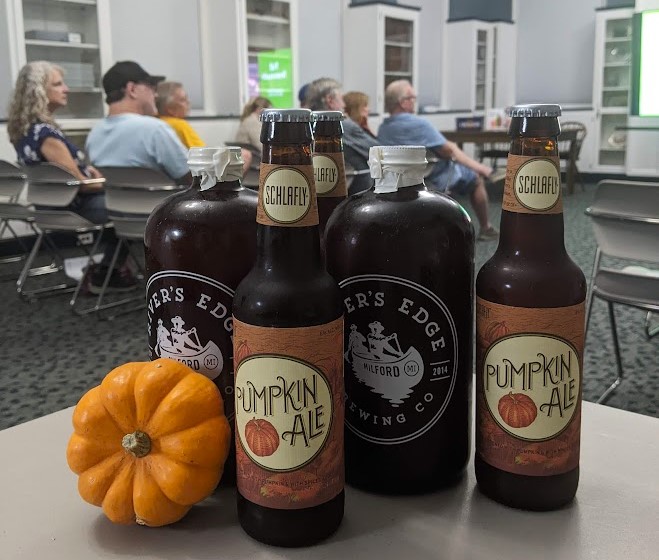As the days shorten and the weather continues to cool, we are celebrating the very best of harvest season by learning about fall seasonal ales! At our late October session of Ale Together Now, Michelle took us back to Colonial America to explore pumpkin beers, and into today's brewing scene to learn about modern harvest ales. Find a cozy spot, don your most fall-friendly sweater, and join us as we learn about these fantastic fall seasonal varieties!

When we think of pumpkin ales, we often picture cinnamon, cloves, and nutmeg combining with squash to create a sweet, spiced drink. While this makes a perfectly lovely fall beer, this flavor is very modern, and pumpkin ales have a much longer history than the pumpkin spice craze. Pumpkin ales are attributed to Colonial America, where squash grew abundantly and was a staple of many kitchens. Baked to release their sugars, pumpkins were a perfect ingredient for providing a fermentable sugar source in brewing. Other common adjuncts in Colonial brewing include molasses, brown sugar, pine, and sassafras. Pumpkin beers were viewed as healthful, and were even prescribed by physicians along with bran beer. Even George Washington allegedly had his own recipe for pumpkin ale. By the nineteenth century, malted grain became more widely available in the US, and pumpkin was enjoyed more as a flavoring agent in brewing than as the primary sugar source.
We sampled No Spice from River's Edge Brewing Company, a pumpkin beer that is earthy, malty, and spice-free at 5.5% alcohol by volume (ABV). This is a more traditional recipe than many pumpkin beers that we see today.
Beer and breweries were a huge part of Colonial life. Court was held at taverns, and local gossip and other community events often took place at local taverns. The Dutch West India Company built the first brewery in a log house in Manhattan in 1632. By 1637, the price of beer was limited to one penny per quart of beer! Blackjacks, which are heavily-stitched, wax-lined, leather made mugs, were often used for drinking. This is definitely not an ideal drinking vessel, especially compared to glassware, but it got the job done at the time!
By the 1770s, most colonial towns and villages had a local brewery or alehouse-- or, citizens simply homebrewed! Many brewers produced English-style ales, but this could sometimes vary.
Pumpkin ales, once a staple in Colonial American homes, are still enjoyed today as a part of the harvest season. Nowadays, spices are often added to pumpkin beers to bring out the sweet, seasonal flavors of this style. The base is typically an amber, brown, porter, or stout, and adjuncts can include cinnamon, clove, brown sugar, and nutmeg. This flavor mimics pumpkin spice coffees or pumpkin pies. From about 2012-2018, this style was wildly popular, but within the last few years we have seen a decline in the pumpkin-spiced beer style.
Next, we sampled Pumpkin Ale from Schlafly Brewing Company in St. Louis, Missouri, a very lightly spiced pumpkin ale at 8.0% ABV. If you're not too sure about pumpkin ales with spice, this is a good beer to try!
Harvest ales are another wonderful fall seasonal style. Though they are characterized for their wonderful freshness of ingredients, they can be widely interpreted by brewers and vary wildly by region. The west coast makes a harvest ale that is similar to IPAs, showcasing the freshness of hops. Around the east coast, we see harvest ales that accentuate the malt profile, creating a beer more similar to an amber or brown ale. The Midwest tends to produce hoppy ambers or pale ales, since we boast a great climate for growing both hops and barley.
Since harvest ales are meant to represent the seasonal harvest, they rely on the freshest grains and hops (which are wet-hopped, providing a uniquely fresh flavor). Harvest ales are served immediately after primary fermentation to showcase the ingredients used in brewing. Harvest ales seem to be growing in popularity, and there are many local examples of this wonderful style!
We sampled Saleabration by River's Edge Brewing Company, a light, malty, fragrant wet-hopped lager at 5.0% ABV.
Michigan produces fantastic harvest ales because of our local producers! Michigan brewers can source from sixteen different hop farms throughout the state and four malt houses. There is one major yeast lab in the state, but many large breweries also have their own yeast labs. Plus, Michigan has plenty of fresh water to work with!
Our last sample was Harvest Ale from Drafting Table Brewing Company in Wixom, which is a crisp, wet-hopped pale ale at 6.0% ABV.
Fall seasonal beers are the perfect way to celebrate the transition of summer into fall. They elevate local and seasonal ingredients and represent the culmination of another growing season. This fall, be sure to check your local breweries and beer stores for a pumpkin ale or harvest beer, and be sure to try the many wonderful variations of both of these styles!
Cheers!